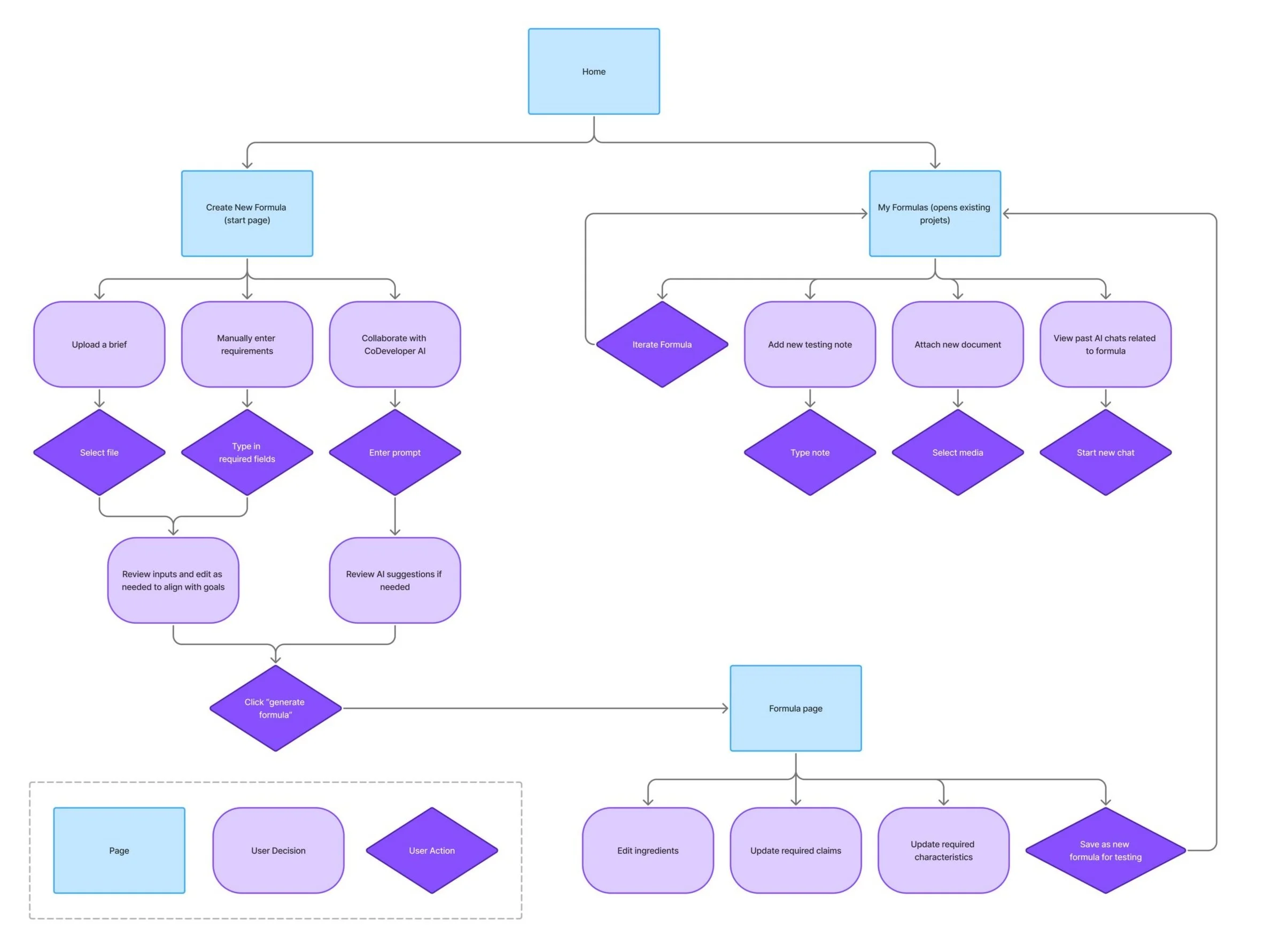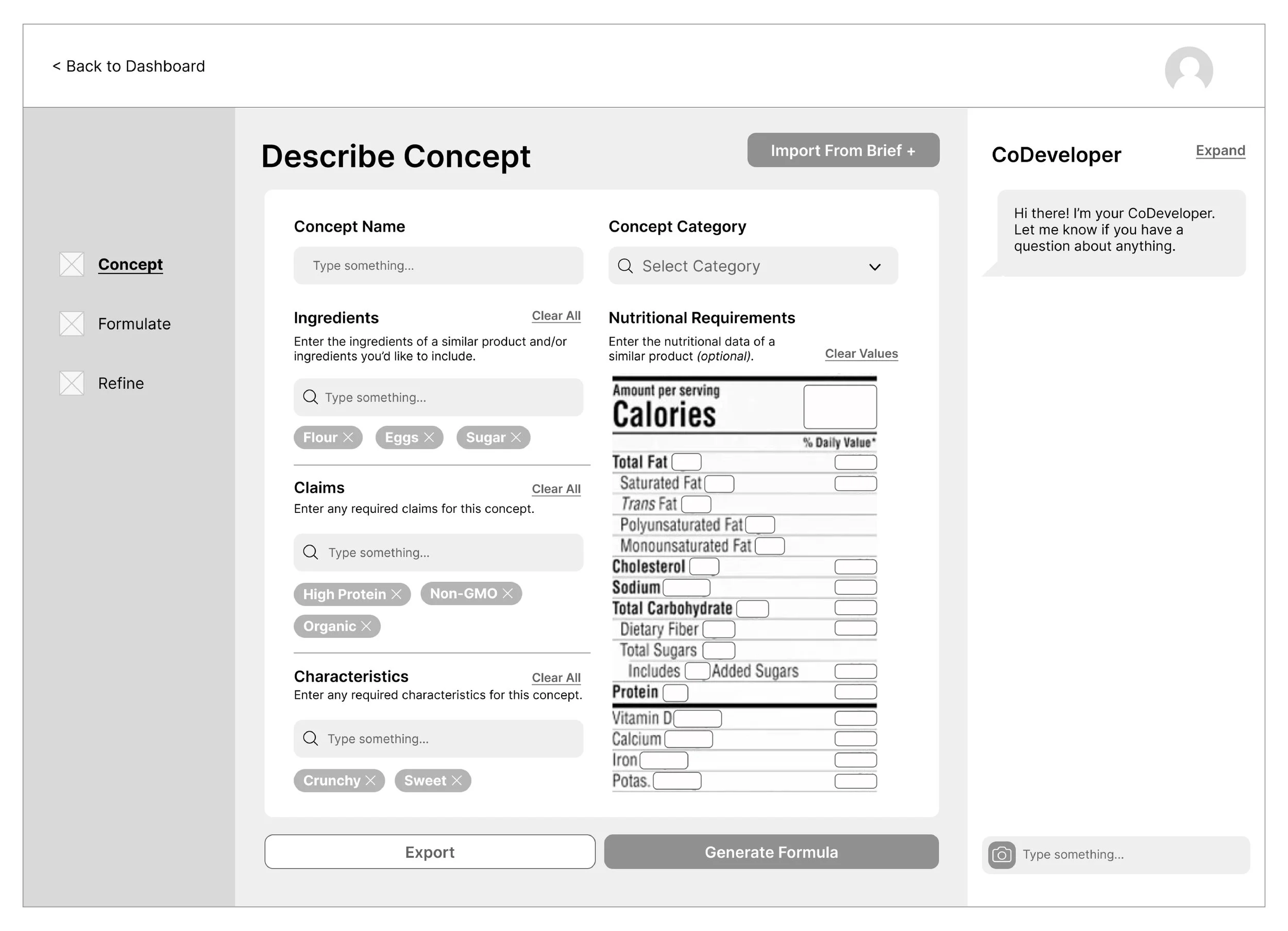
Culinivo
UX/UI Design | Enterprise SaaS
How food scientists can quickly iterate and develop new formulas.
Culinivo is software application idea that can speed up time to market, support innovation, and provide access to valuable information during the concept and formulation processes for food product developers.
Project Overview
Problem
Food scientists need a way to quickly create and iterate when developing new formulas for processed food items in order to meet demand.
What We Did
User-test two formula generation methods in a new AI-driven food science application. This study would provide valuable data and insights that the client could use to gain buy-off from their corporate board and investors for funding and development.
Results
95% of testing participants agreed that Version 2 of the product serves as a solid starting point for trial formulations and would add value to their workflow.
Defining The Problem
75% of surveyed food developers noted that time constraints and formulation issues were the top challenges faced when developing. Our client came to us with the desire to create a new product that would leverage AI to automate and speed up certain aspects of the development process, while also compiling some of the methods they currently use into one place.
The goal of this first phase was to conduct user testing with interactive prototypes in order to gather quantitative and qualitative insights from users. This data would then be provided to the stakeholders so they could present the findings to their corporate board and secure funding to support development and launch of the product.
Key Feature Requirements
Generate Base Formulas with Ease
Auto-generated dynamic formulas based on user-inputted requirements. The software’s ability to review claims will help ensure all food products and processes comply with local, national, and international food safety and quality regulations.
Easily Reference Formulas
Store, organize and add notes to formulas for easy reference during refinement (testing) stages, improving overall productivity compared to old methods like spreadsheets and handwritten notes.
Expert Guidance
The Generative AI chat feature acts as a knowledgeable resource, offering expert guidance on formulas, identifying errors, suggesting improvements, and keeping developers informed about industry trends.
User Flow
Because this project was focused on gaining initial insights on the core capabilities of this product, the team opted to keep user flows simple and streamlined so as not to overwhelm our users during the testing.
While additional flows such as an ingredient shopping component, virtual kitchen and industry news exploration feature were all discussed, ultimately we kept the functionality simple: the user creates a new concept in 2 ways (manually uploading information and collaborating with an AI-chat) and then refines their concept by updating ingredients, amounts and adding notes.
Early Insights with Wireframes
Through our research, we discovered that food developers work in three stages: concept, formulate, refine. The developer has an idea for a new product (and will often use an existing product as a starting point), then creates a new formula or recipe, and then tests and iterates the formula repeatedly until the right taste, texture and consistency are achieved.
The initial wireframes I designed included a side-panel navigation that was taken over by a sub-menu of “concept, formula, refine” once the user started a new concept. After initial tests, it was determined that it was unnecessary to have “concept” be a fixed page at all times since users would need to easily switch between the formula and refine phases once the initial concept was created.
The nutritional panel was also converted from a form-fill to a photo upload in order to provide more value to the users when working from an existing product.
Additionally, early versions of the wires included a form for the user to fill out in order to generate a new concept. After presenting the screens to stakeholders though, the team agreed that a full-screen chat interface would be more valuable to test with users.
User Testing with High-Fidelity Prototypes
One key item that we tested was two methods of starting a new concept: Version 1 showed manual inputs for ingredients, claims and characteristics plus the ability to take a photo of an existing product label to start from. The second version featured using a conversation with the CoDeveloper AI as a way to begin the process.
Version 1
The first version tested with users was closer to how food developers currently begin their process, but with a sleeker interface and step-by-step entries for required ingredients, claims, and characteristics. Nutritional requirements of a similar product to start from (in initial user research, we uncovered that this was a method many developers use to get started) are optional and can be uploaded in a photo.
While interviewees agreed this first version could serve as a decent starting point for trial formulations, they did not feel it was innovative enough to impact their development process.
Version 2
During the second version testing, we saw an attitude shift that indicated the interviewees were becoming excited about the potential of the application. When the advanced capabilities were presented (specifically proactive AI and ingredient substitute features), the interviewees became more engaged and interested, even interrupting the demonstration to ask questions and provide thorough feedback.
Most participants agreed that Version 2 was a significant step up from Version 1 and were impressed with how AI could be used in the product development cycle. 95% of participants shared that this phase serves as a solid starting point for trial formulations because it provides developers the opportunity to formulate more upfront before going to the bench, ultimately resulting in time and cost savings.
Formula Refinement
Once an initial formula is created, the user is led to a Formula page where they can easily add new claims that are met by the formula and adjust ingredients. The agentic CoDeveloper AI provides real-time feedback when claims aren’t met and offers solutions that can be implemented with one click.
Iterate Formulas and Store Notes
The last phase of the prototypes shows how once a formula is created, developers can store notes, photos and videos within the app while they perform their tests at the work bench. If new formula iterations need to be created, the user can return to the formulation screen to make adjustments and save new versions.
Results
Initial results during user tests of this product showed a positive impression with users surveyed, satisfying the stakeholders to bring our findings to their board.
93%
Average decrease in time spent creating base formulations before testing at the work bench.
95%
Of participants agreed the product serves as a solid starting point for trial formulations.
Created with Brightfind Inc.



